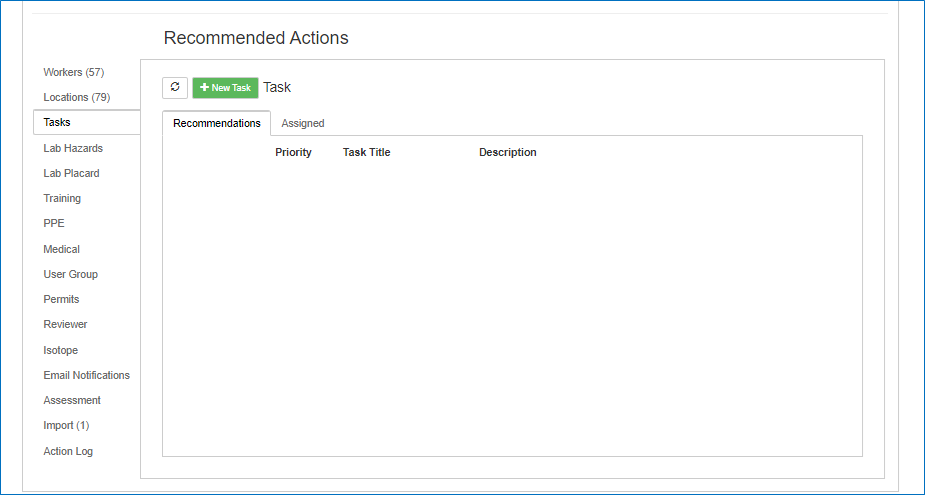EHS Assessment Overview
EHS Assessment - Overview
The EHS Assessment application allows EH&S authorized staff to create safety related forms for updating safety related communications between EH&S and clients. These forms are created to facilitate the submittal of safety related information related to the authorization of activities within the facilities environment. The forms are typically directed to a Principal Investigator, Department Manager/Supervisor, Individual Employee, and/or Employee Supervisor. This approach allows EH&S to direct the appropriate form to the individual who is responsible for the entry and documentation of safety information required within an organization.
Examples of these applications/forms are:
- Permit Authorizations
- RAM Permit initial authorizations, amendments, renewals, reviews, and terminations.
- IBC, IACUC, Biological authorizations
- DEA, Hazardous Chemical authorizations
- Laser and Xray authorizations
- Miscellaneous Forms
- Confined Space Permits
- Hot Work Permits
- Pregnancy Declaration Notification
- Training Requirements
- Restricted Gas Authorization Requests
- Hazard Assessment Submittals
- Safety Plan Submittals
- Chemical Hygiene Plan Submittals
The EHS Assessment includes the following menu options:
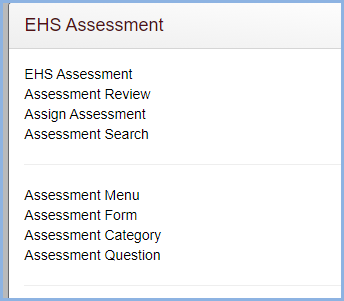
The PI's or Lab Managers will enter information and answer the assesment questions for their labs from the EHS Assesment PI menu option.
This menu is configured to show the forms that individual users are required/allowed to access.

For Administrators and those that will be maintaining the forms:
Select the Employees icon from the Main Menu to view the menu selections. Then select the options under EHS Assessment to view and create the Assesments you will use.
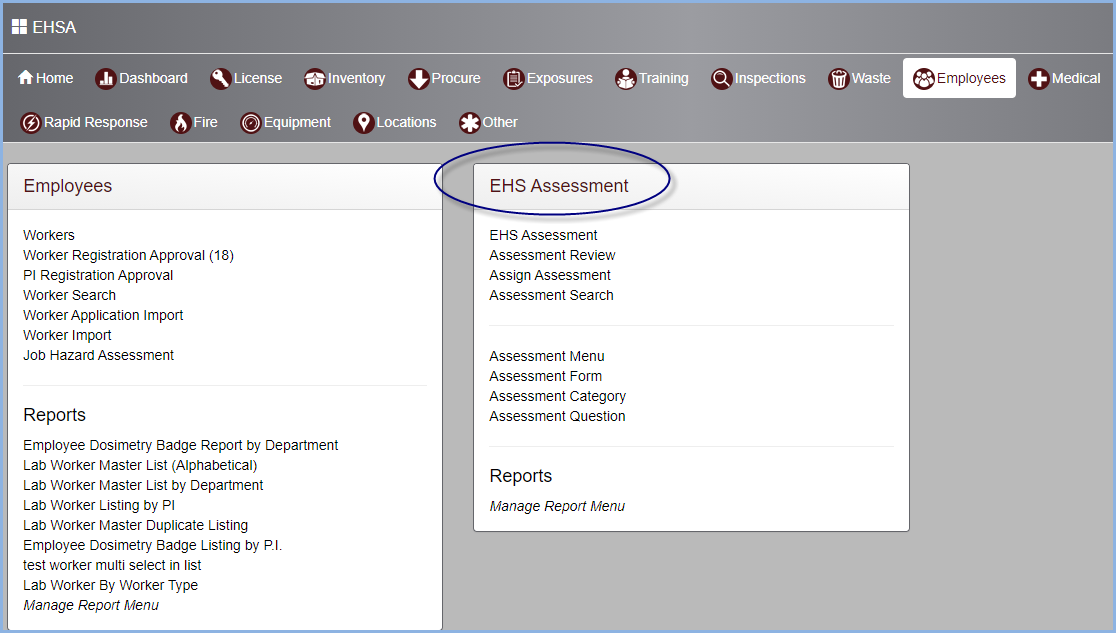
- This opens the Assessment listing screen. The assesments can be viewed by the status selected in the Status dropdown, the default view is Pending.
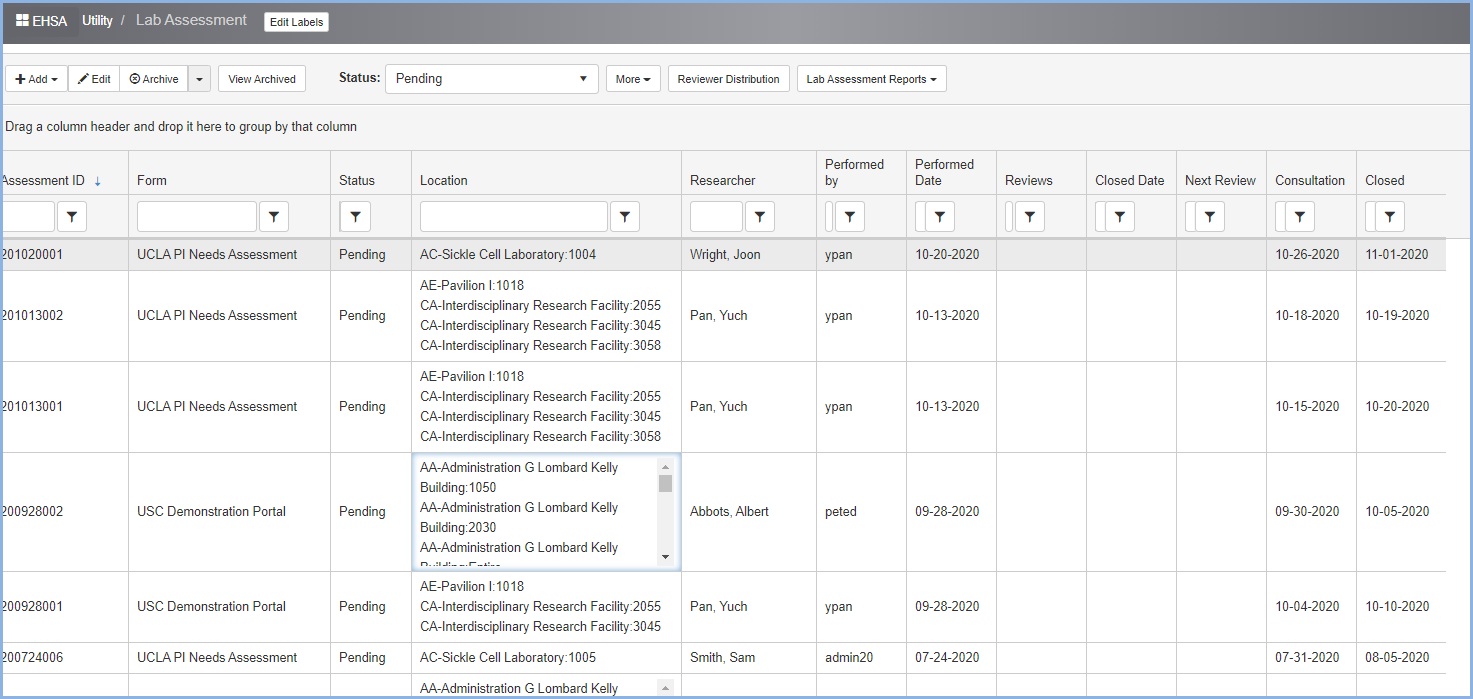
- The More menu options allow Administrative personnel to create the forms and questions for the Lab Assessments.
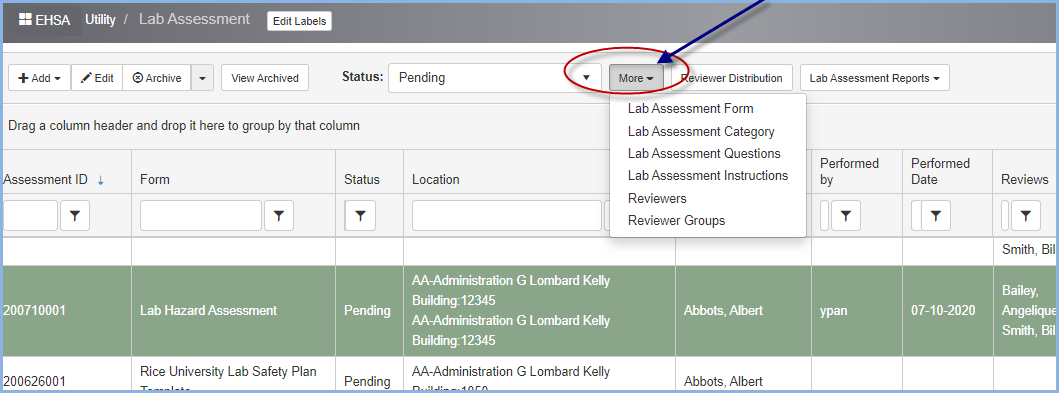
Lab Assessment Form
Select from the More menu to open the Lab Assessment Form list screen as shown below.
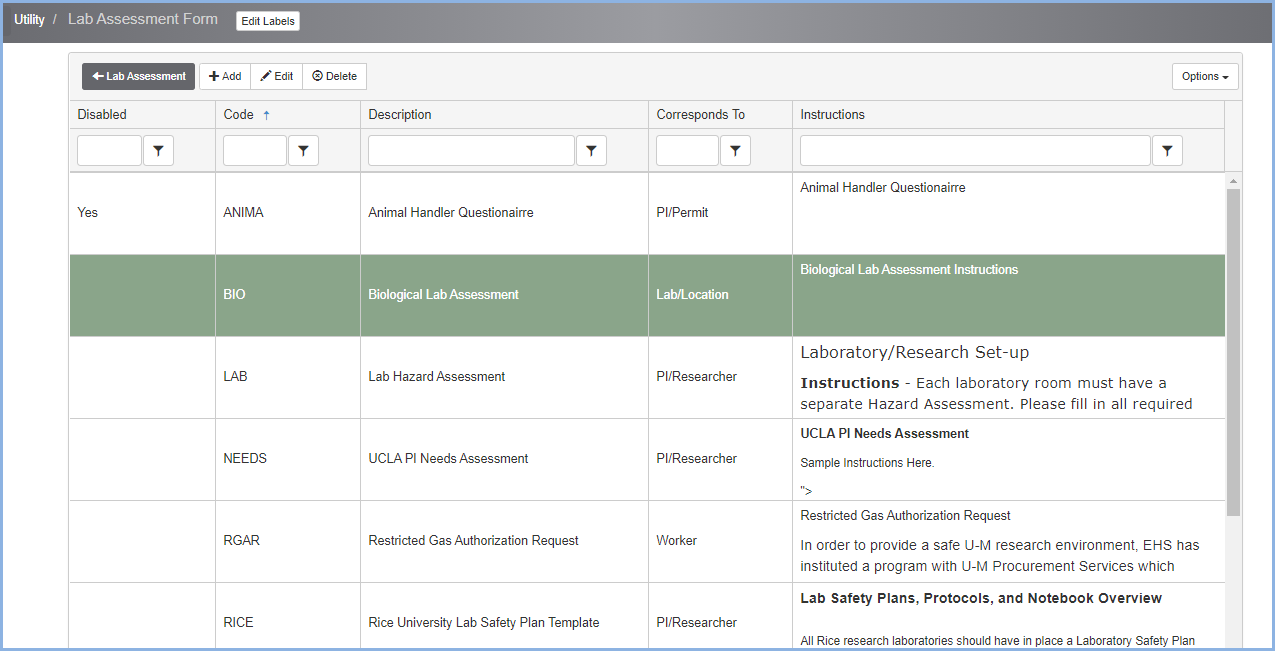
- Click [+Add] to add a new Assessment Form type.
- Highlight a from and click [Edit] to view and/or edit a form's details.
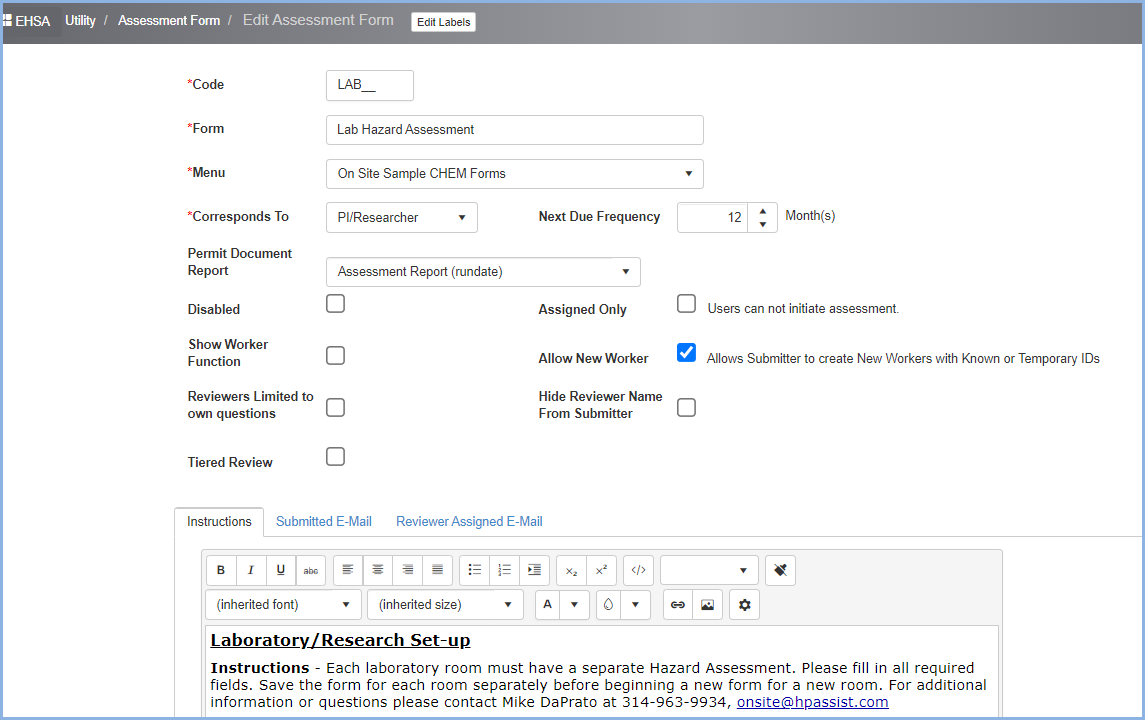
- Code - this is the 5 character code for the form. It is the unique identifier for the form, linking the lab assessment questions and other details for the type of assessment. Simple examples are IBC for IBC Protocol Application, and RMA for Radioactive Materials Application.
- Description - this is the Name of the Assessment Form.
- Corresponds To - Use the dropdown to select who the form is directed to. This is very importante beause this entry creates the framework on the initial form for who will enter the form data.
- Next Due Frequency - Use this field to set any assessment next due month intereval as needed. For example, a Hot Works Permit Form will not have a frequency, but an RMA Radioactive Maerials Authorization might have a 2-year (24 month) renewal process. By setting the frequency, the next due date for a specific task can be updated upon completion of its initial steps.
- Disabled: Check if the form is presently not available to the required individuals.
- Assigned Only - Assigned only allows the scheduling of a specific questionnaire and will not be available to anyone unless that form was scheduled via the scheduling process.
- Show Worker Function - This function allows the PI the ability to update the Worker Function as the employee is added to the initial personnel/worker application. This would typically be used during a PI on-boarding process.
- Allow New Worker - This check box will allow for the entry of an individual who is not presently in the organization's worker table but you would like to enter their information. Once the individual's organization ID becomes available, the information entered will be assigned to that specific ID.
- Reviewers Limited to own questions - This check box checked only allows for the reviewer to see his/her own questions/comments.
- Hide Reviewers Name From Submitter - Check this box if you do not wish to indicate to the submitter who is asking the review questions. This would indicate to the submitter that someone authorized to review their submittal is asking a question(s).
- Tiered Review - The Tiered Review box allows for the entry of multiple reviewers that have sequential review of the specific form. It should only be used if there are individuals that you require a review from that are not part of the overall review group. This is the most complex capability within the application during the review process. An example of this is a Worker Registration form that must be approved by the worker's supervisor. This supervisor can be the PI or it could be simply the individual that the submitter reports to. The application will auto-populate the supervisor of the submitter if the supervisor is linked within the submitter’s worker record. If the supervisor is not listed, you will ask a question as part of the submittal: "Who is your supervisor?" or "Who is the PI that you report to?". This allows that the setup will show that the supervisor/PI must review the form initially before the form is submitted for review by a specific committee or approval group. Once the supervisor/PI approves the form, an auto-email with the specific URL will be sent to the next individual and/or committee for review. The following tab will appear once the check box is checked.

- Tiered Review Tab - The Tiered Review Tab controls the documentation of those submittal forms that require a sequential review and/or signature. The following lists the steps required to enter the required review/signature sequence. Remember that this Tier Review is only used if there is a requirement to send the specific form for review/approval to a specific person who is not part of the committee approval process. Those reviews may be entered as a default for a specific form entered.
- Click the [+Add Tier] box to add a Tier.

- Add the tier information:
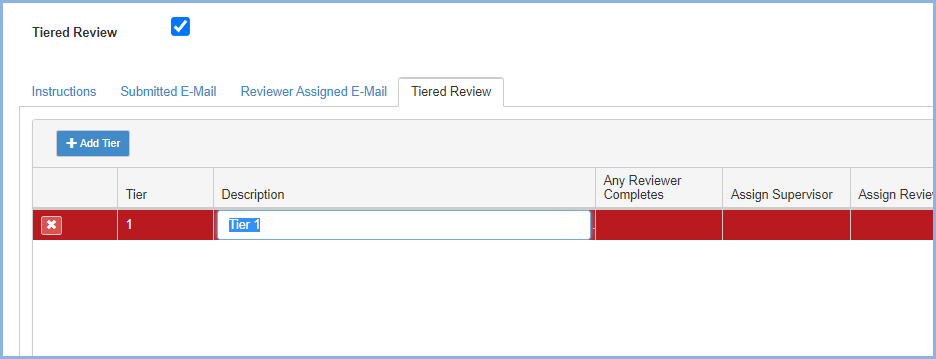
- Instructions Tab - Enter any instructions that are appropriate for the form being entered. This includes special formatting with colors, type style changes and the ability to define the purpose for the entry process required.
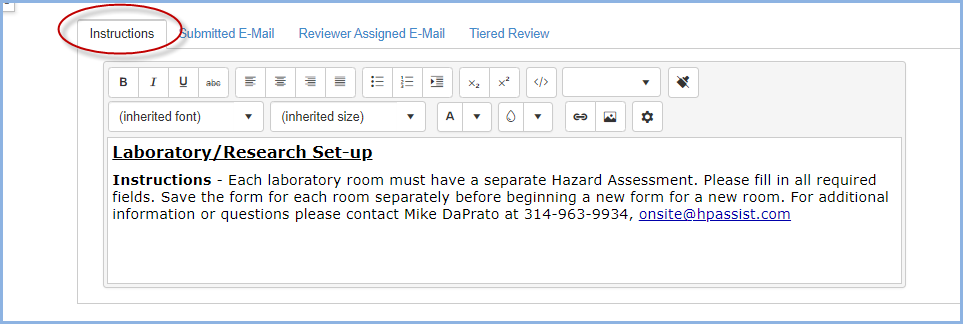
- Submitted E-Mail and Reviewer Assigned Email Tab - This tab is used to enter the notification emails after an individual has submitted a new form.
- Reviewer Assigned Email Tab - This tab is used to enter the information sent to the reviewers when they are assigned to reivew a form.
- Click [Save] to save all entries made on this screen.
Lab Assessment Category
The Lab Assessment Category divides that application into required groups. The category defines the structure of the form.
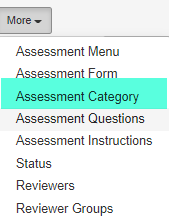
The following example illustrates the potential of this process.
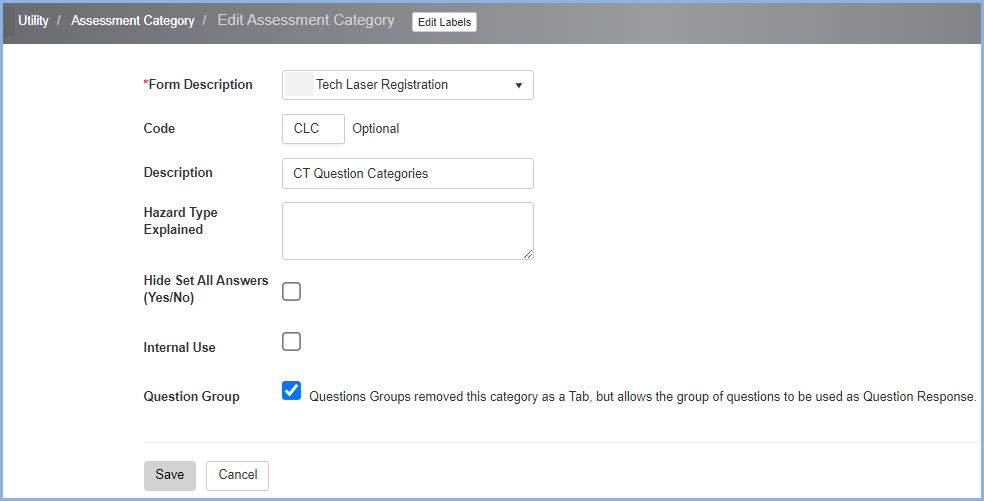
Select from the dropdown of forms that the categories are being added to.
- Code - Enter the Category Code. In the example above ARU relates to the category Are you using? In the next section of questions, you will enter questions that will define the usages of different types of material that require specific documentation.
- Description - Enter the description of the category. A category can be anything that makes the process simpler and or more specific to the form being created. In the example, the description is Are you using?
- Hazard Type Explained - If more definition of the category is required or if instructions in answering questions for the category, list those definitions and instructions.
- Hide Set All Answers - Check this box if the questions within the category do not require Yes/No answers. By checking this entry, the Check All Yes or Check All No will not appear.
- Internal Use - Check box indicates that this category is used for Internal Use Only. These questions will not be seen by the submitter but only to the reviewers within the review process.
- Question Group - Check this entry if the questions within this category allow for the entry of multiple answers for a specific question. Examples are:Multiple personnel, multiple Lab/rooms, multiple Agents, etc. This grouping is a very important feature the Safety Portal. This feature will become clearer once you become familiar with the question creation within the application.
Assessment Questions
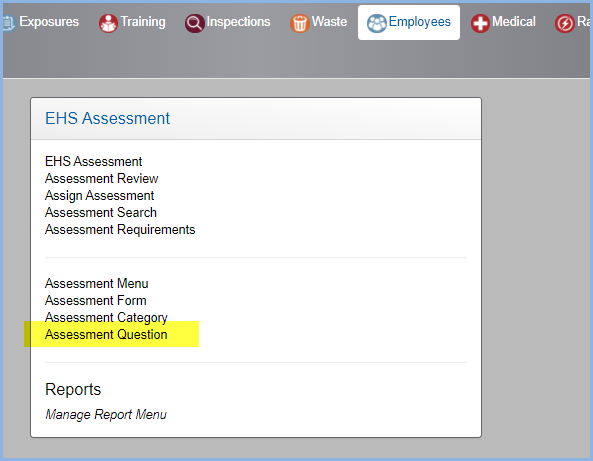
The Assessment Questions can be potentially the most powerful and most creative part of the Safety Portal. This is where one determines the results of the form being created. Are you looking for answers only or do you require to update information in the EH&S application that are generated from the results of the questions asked? By properly asking questions, Hazards, PPE, Medical Surveillance, Placard, Personnel, Locations, Tasks, Emails, and Permits can be created or updated subject to the answers and the approval process.
- The Questions can be accessed from the Main Menu options above, or from the More menu within the Assessment Listing screen as shown below.
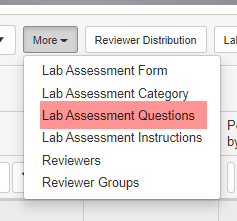
- Select the Assessment Form from the dropdown. The questions will be grouped under the Categories for the Form.
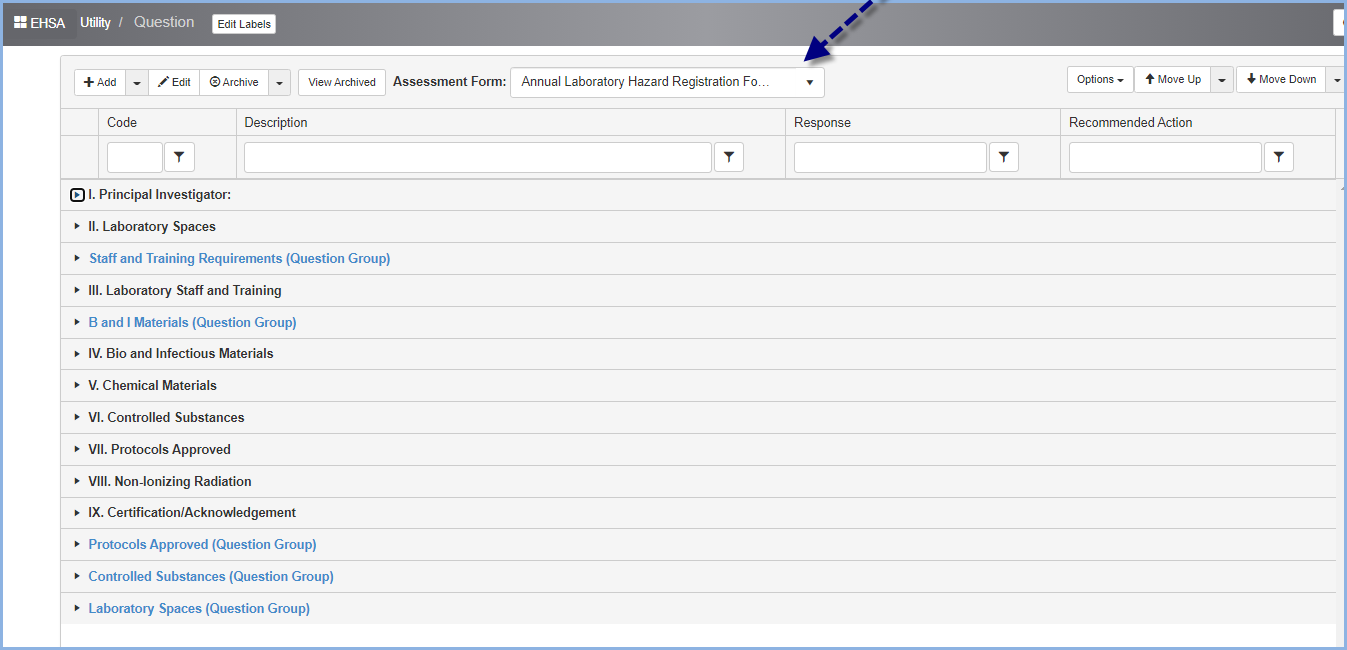
- Click on the arrow beside the Category to open the list of questions.

- Assessment Question example:
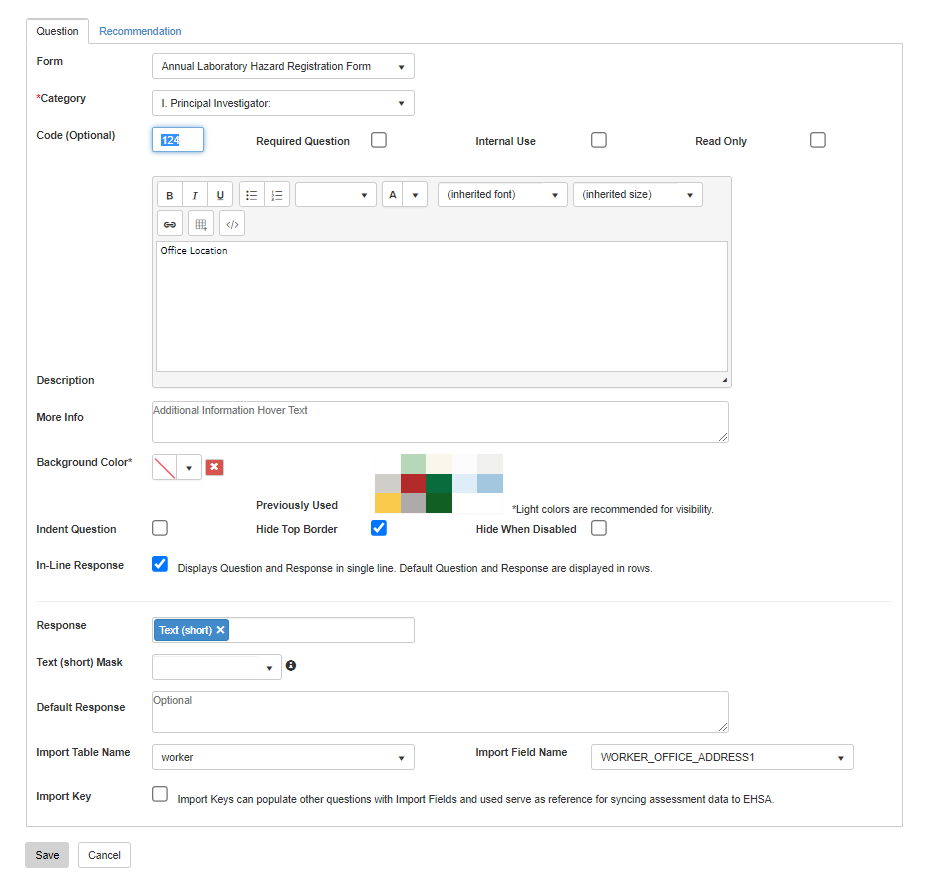
- Form Description - Select the overall form that these questions will be added to.
- Category - Select the specific Category that the questions pertain to.
- Code - Enter a specific Code. The Code is optional and will be auto created by the application. The code is only used to facilitate the questioning order. The code is not required to be in any specific order since the order of questions and categories and be graphically changed within the application.
- Required Question - Check if question is required If the question is checked and the user does not answer the question, the form will not be submitted until the answer is updated.
- Description - Enter the question in the Description field. The question can be formatted with the formatting tools available within the control. The question can be entered in a specific typestyle with further explanation being presented with formatting like underline, bold, and/or a different typestyle.
- More information - The More information box is used to enter hover text for more information concerning the response that is expected, required, or rationale.
- Background Color - A selection to change the background color is available. You can choose from the color schema and apply that color to your question. In addition, it will save the previously used color choices to the right of the box so that you can choose within the same application exact color matches for different questions.
- Indent Question - Check the Indent box if you require your question to be indented from other questions or instructions.
- Hide Top Border - The form will auto enter a line before each question unless the Hide Top Border is checked. This helps in grouping like questions together, ie personnel information questions.
- Hide When Disabled - If a question is disabled which is controlled withing this same form, there is a choice on whether to disable the question (the answer type is disabled) or hide the answer type completely. Check if you would like to hide the answer completely.
- In-Line Response - If you would like the question and response on the same line, click the In-Line Response Box. This feature is aligned with shorter answers. If you are asking for a paragraph it would make sense not to check this feature. By using this feature, your questionnaire will be shorter since typically there is only one line per question.
Response
The Response dropdown contains all available types of answers. The Safety Portal allows for the selection of multiple types of responses for an individual question. This allows for additional functionality.
Response types:
- Yes/No
- Text (short) - Use if answer is less than 50 characters
- Text (long) - Use if answer is longer than 50 characters, paragraphs
- Number - Use for phone numbers and numeric responses
- Checklist - Use for a special checklist, Yes/No/NA, BSL1, BSL2, etc.
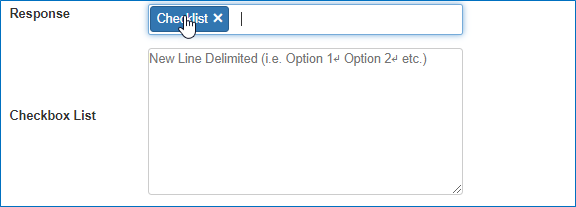
- Radio - Use for a special list, Yes/No/NA, BSL1, BSL2, etc.
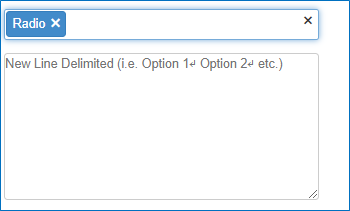
- Date - Calendar date only
- Date end - End date of month selected
- Date time - Date and time displayed
- Attachment - Offers a link to attach document or pictures detailing the specific question
Here is an example of a question requiring an attachment:
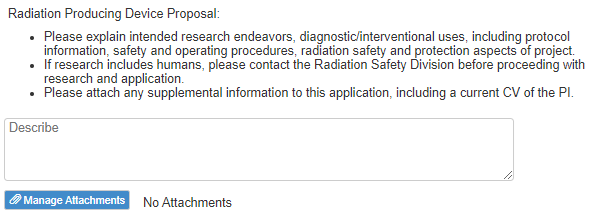
- Single Worker - Dropdown of worker table with the selection of only one employee/worker
- User Defined Workers - This response allows for workers entered on the initial PI entry form to be used later with other questions that require an identification or verification of a personnel/worker.
- Multiple Workers - Allows for the entry of multiple workers in an answer box
- Single Location - Dropdown of Location table with the selection of only one location
- Multiple Locations - Allows for the entry of multiple locations in an answer box
- User Defined Locations - This response allows for labs/rooms entered on the initial PI entry form to be used later with other questions that require an identification or verification of a lab/room.
- Custom Dropdown List - Creates a dropdown from a keyed or copied list of elements, Yes/No/NA, BSL1, BSL2, etc.
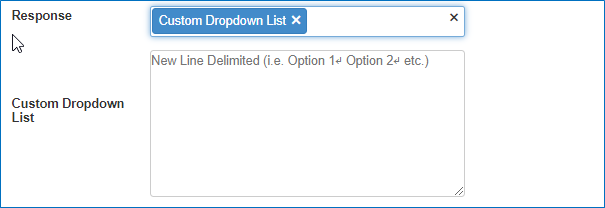
- System Dropdown List - Dropdown list provided from a master list of tables within EHSA. When this option is selected, a list of available tables will be provided for selection.

The actual System Dropdown List is a prepopulated list of available tables that can be utilized that are part of the EHSA application. An example might be to select Department for a list of Departments to choose from.
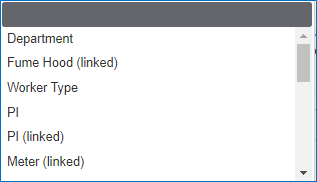
On certain controls that are linked to tables within EHSA, the ability to Allow Free Text is available. This allows for the bypassing of the actual data within the dropdown and offers the ability to enter text.
- Question Group - If the question requires multiple answers select this option to select the list of questions from your dropdown category.
- Signature Verification - Signature Verification offers a link to the person(s) that are logged in verifying that they are the person(s) agreeing to or signing the proposed for acknowledgement. Below is an example of the results of using the Signature Verification to the question concerning Acknowledgement.
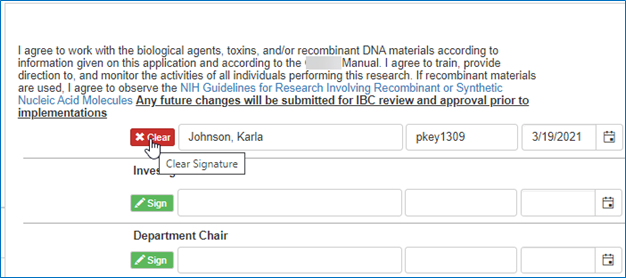
- Grid - A list of prepopulated grid answers that are linked to EHSA, Isotopes, DEA scheduled items, biologicals
- Isotope List (built from grid) - Specific list of isotopes that have are created from either the organizations license or a specific PI who is filling out the form.
- No Response - No response is required. This answer type in used when a block of text is needed for explantion with no question or response needed.
- Default Response - The Default Response is used to suggest to the user an answer that can be edited or cannot be edited but used as part of their response. An example of this might be a Default Response indicating the security required a certain protocol within a lab. A request to update the default can be indicated and required as part of the answer.
- Import Table Name - This dropdown is a selection of available data that has been populated from EHSA. The table that is selected is the one that the list is populated from.
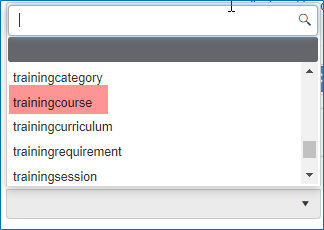
- Import Field Name - This is a list of the fields within the table that are available to display and saved in the field selected. An example is selecting the training table and displaying training dates and pass/fail information.
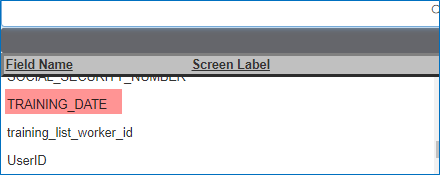
Changing a Single answer to a multiple answer question
One of the most important features of the Safety Portal is the ability to change a single answer to a question to a multiple answer question. Some examples of this feature include:
- Multiple personnel/employee selection
- Multiple Lab/room/suite selection
- Funding sources
- Biosafety Cabinets
- Waste Disposal/Decontamination Processes
- Viral Vectors
- rDNA
- Radioisotopes
- Lab/Room Contacts
- DEA/Controlled Substances
- Committee Membership
- Injury/Illness Recommendations
This is only a small list of potential sources that might require multiple entry.
The process begins with the creation of a question with a single list of fields that require entry. The example for this documentation is personnel/employees associated with an IBC Protocol.
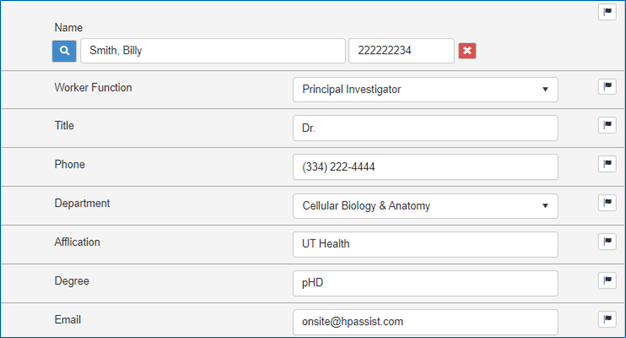
- This single-entry question was created as a simple list of questions with 8 fields. Once this has been created you could use this as a data entry form if you are only trying to document a single worker. If you would like to turn this into a multiple record response, the following steps are required and very easy to accomplish. The result of converting this question to a multiple entry question is shown below.
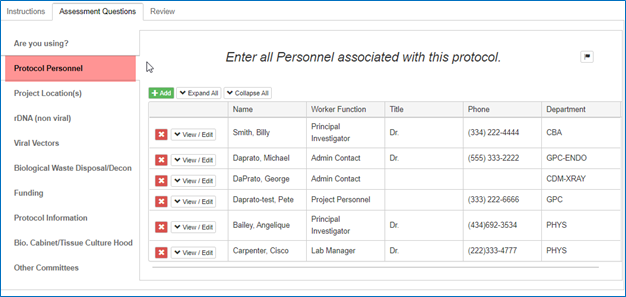
- The category for this list of questions will require a minor change.
The question group listed below will require the check box Question Group checked. This indicates to the application that this group of questions is now designated as a multiple answer question.
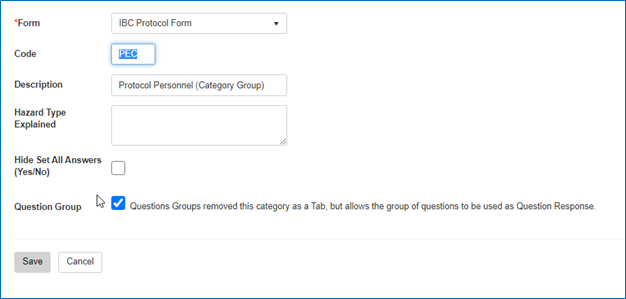
- You are required to set up another question that will be linked to the question group category. This question can be added to its own separate category or it can be added simply as another question to an existing category. In this example, the question will be added to its own separate category. You will notice that the question group is not checked to category that will contain the multiple answer question. This is only checked on the category that contains the questions.
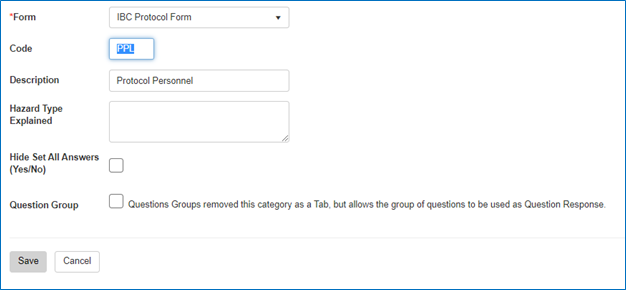
- The next step is to add the question that will result in the multiple question answers.
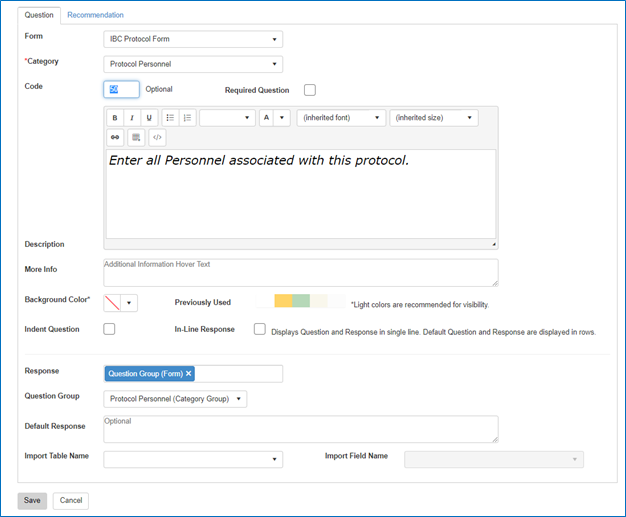
- Enter a question like the example above which indicates Enter all Personnel associated with this protocol.
The response is Question Group Form. This will now give you in the next option field Question Group. That gives you the choice of where your questions reside in the application. In this case I set those up under Protocol Personnel (Category Group).
Your results now will be a Multiple answer question.
If you do not want a separate category for the Protocol Personnel, you can add that question to another category.
Recommendations Tab
Within each question, recommendations can be generated depending upon the answer type. An answer to a question might be that Lab/Room 1003 contains oxidizers. By knowing that the question created an answer, then you could link a specific hazard and auto populate the hazard to the lab.
- Hazard Type - The form below gives you this capability. Simply select the Hazard type, description, detail (if required), and detail memo (if required). This will update the lab with the hazard(s) once the form has been reviewed.
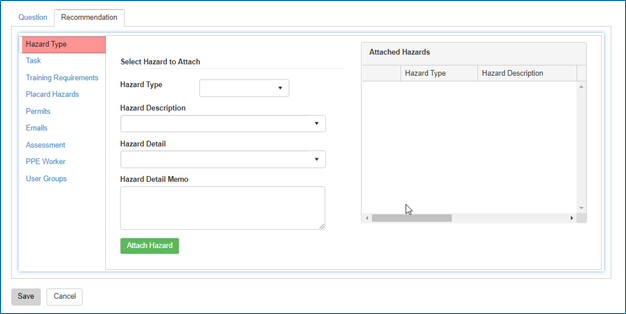
- Tasks - Certain tasks can be generated depending upon the answer. These tasks might entail the generation of a specific task that typically is created when the specific question is answered 'Yes'. This might entail notifying the respondent that he/she are required to contact a specific person responsible for the next steps in the process that is required. An example might be that they need to contact Radiation Safety to schedule a conference to discuss steps required to proceed with the use of radioactive materials at the institution.
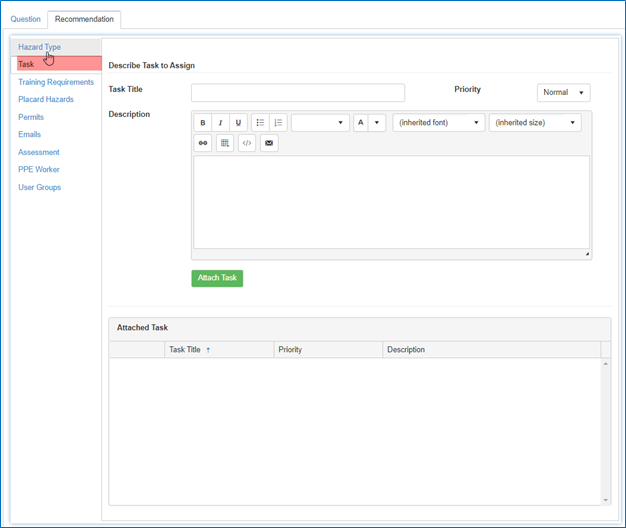
- Training Requirements - This recommendation will create a training requirement based upon the question being answered in the affirmative. The question might be: "Do you require a respirator: Yes/No". If the answer is 'Yes', recommendations are generated to check if a certain training requirement has been added to the employee in question. If requirement is not in place, the requirement will be added and any training history that is linked to the requirement. If the training course has a frequency, the next due date will be calculated and added to the training requirement.
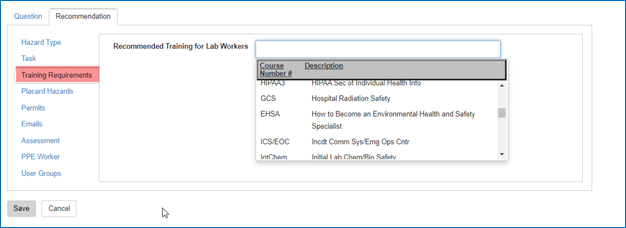
- Placard Hazards - Placarding is an additional option depending upon the answer to a specific question. Assignment of an image to a question and lab/room/suite, initiates the adding of an image to the placard. For instance, if a questions answer is 'Yes' to Flammables within a Lab/room, the image is added.
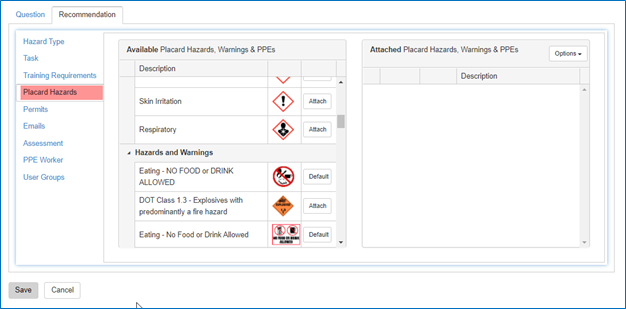
- Permits - Upon review and final approval of the information added to the form, the reviewer has the ability to add a permit and assign that permit to the specific responsible person. This permit could be a place holder until further documentation has been received or additional forms are reviewed and approved.
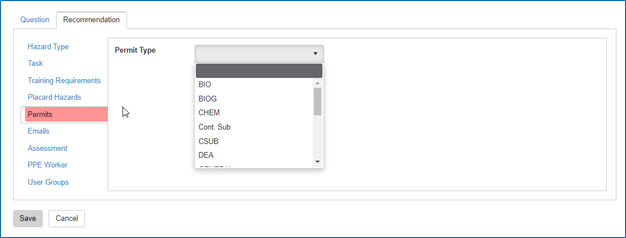
- Emails - Emails to collegues with notification of the current status/disposition of the approval process. This could include a hand-off of the next steps required for approval or additional information requirements.
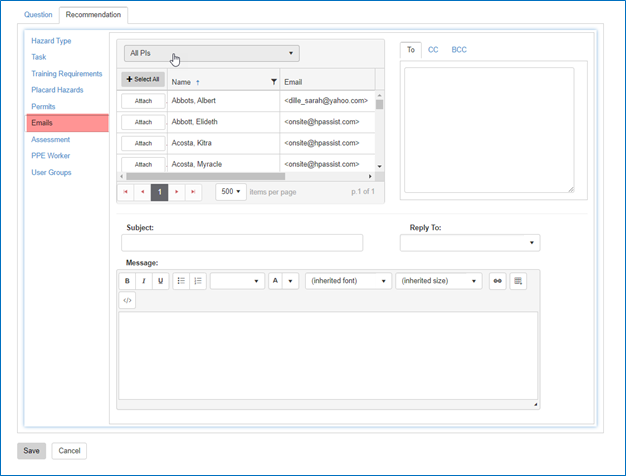
- Assessments - Other questionnaires and/or forms are required based upon the answer to a specific question or the evaluation of an entire form. For example, The RAD Materials Authorization is required if a specific question was answered in the affirmative and the RAD Materials Authorization Assessment is required.
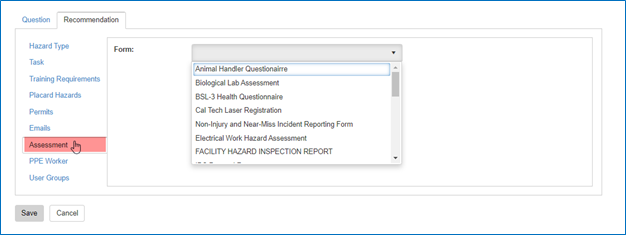
- PPE Worker - This recommendation will create a PPE requirement based upon a question being answered in the affirmative. The question might be"Do you require a respirator? Yes/No". If the response is 'Yes', recommendations are generated to check if a certain PPE requirement has been added to the employee in question.
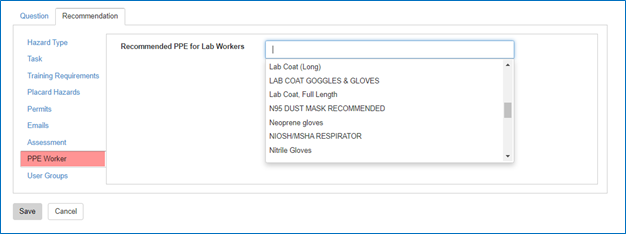
- User Groups - This recommendation will add the employee to the specific Security User Group based upon a question being answered in the affirmative.
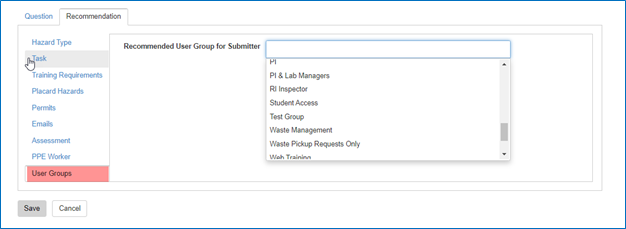
Workflow and Form Review
A workflow can be defined as ‘Workflows are the paths that describe how something goes from being undone to done, or raw to processed.’ The overall workflow of the Safety Portal is categorized as:
- Form Availability
- Initial Form Entry
- Form Submission
- Form Review
- Form Questions/Comments
- Responding to Questions/Comments
- Form Approval
- Form Recommendation(s) entry/update
- Form Availabilty
- There a number of ways that a form(s) can be available to a Worker and/or P.I.. This entry point can vary within each form generated. The form availabilty becomes very important since the workflow can be tailored toward the form, its review, and eventually its approval. Most forms are reviewed by at least one reviewer and in some cases may include multiple reviewers, depending upon the sophistication of the form and its subsequent workflow application. They are:
- Accessing form via EHS Assistant
- Accessing the form(s) with EHS Assistant is very easy. The submitter must have access through the security role access to specific form(s). These forms can be controlled with the user record assigned to each individual that has access. This is accomplished by giving access to all forms that a user may enter and submit.
- Accessing form via URL
- This example includes form(s) like Confined Space Permits, Hot Work Permit, Preganancy Declarations, etc, where the form is created and typically does not have a specific frequency but is created as needed.
- Assign Accessment
- Scheduling an individual to submit a form is another option available. This capability would typically be used when a specific form has a requirement that must be met and it makes sense in scheduling the form creation for the intended recepient. An example is schduling a PI On-boarding form required prior to a prospective PI starting his/her first day of employment. The form can be created and directed to the prospective submitter via a email. This eliminates the need for the recepient to create the form for themselves. Another example is a person who is required to update their permit annually, the responsible individual could create the assessment and email the individual with the URL for completion.
- Initial Form Entry
No matter if the form is being created by a worker within a lab environment or created by a worker within a facility, the process of entering the form is very similar. The questions required for the form being created may include prepopulated answers based upon the type of question asked. An example of this is the question concerning the department of the person filling out the form. If linked as an example to the institution's authentication server, data like department, facility, address information, etc. can be autopopulated from the linked authentication server. Any additional questions that require answers will be available. Some questions maynot be required while others are required to be answered. You will not be able to do a final submittal unless all of the required questions are answered. Also, there maybe conditional questions that depending upon the answer, the next question may be required or it may be skipped. Those types of questions will be hidden or disabled depending upon the setup.
- Form Submission
As users are filling out any form, there is a [Save Progress] button at the bottom of the page that will allow you to save the data entered on the page that you are working on. The [Next] button will take you to next subcategory or page to continue the process. The [Save as Complete] button to the right of the page will allow you to submit the entire form for approval. If all required questions are answered, the [Save as Complete] button will display for users to click. The [Assessment Submitted] pop-up box will display and verify that the form has been successfully submitted.

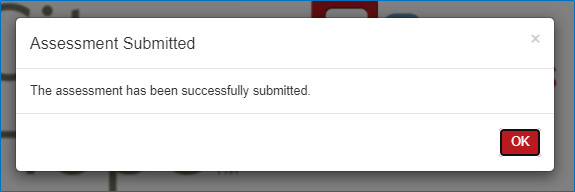
Emails are sent to the individuals that were set up initially as the Reviewers of the submitted form. In addition, the submitter will receive a verification email that the form has been received. This was also set up initially as part of the questionnaire form setup.
If you try to [Save as Complete] a form and all required questions are not updated, the following prompt will appear.
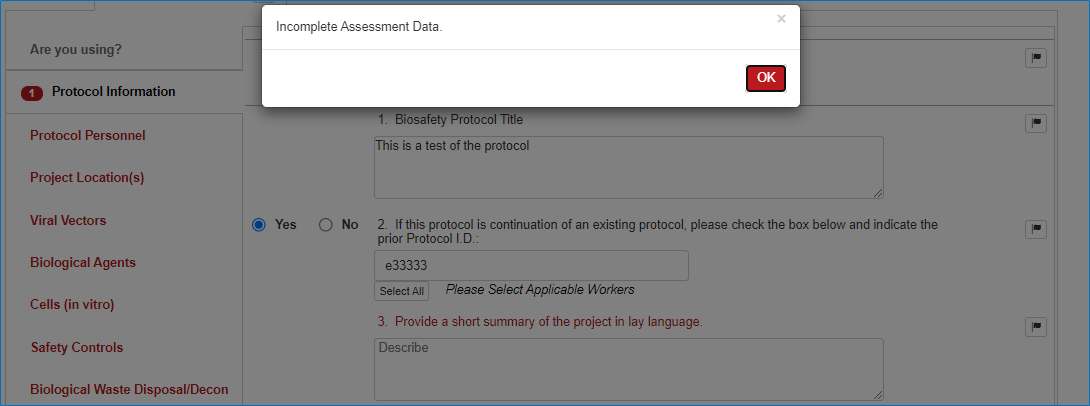
An incomplete question will be shown in Red as question 3 is above. The number of questions required that are not answered will appear at the subcategory display. In order to submit the form, all required questions will need to be answered.
- Form Review
Once the form has been submitted and all questions have been answered, the form is linked to the specific reviewer(s) that have been linked to the specific form. These reviewers can be linked as a default to the specific form or a reviewer can assign additional reviewers. The Reviewers can be defaulted under the EHS Assessment application via the [More] menu button. The following screen will be available to a specific reviewer(s).
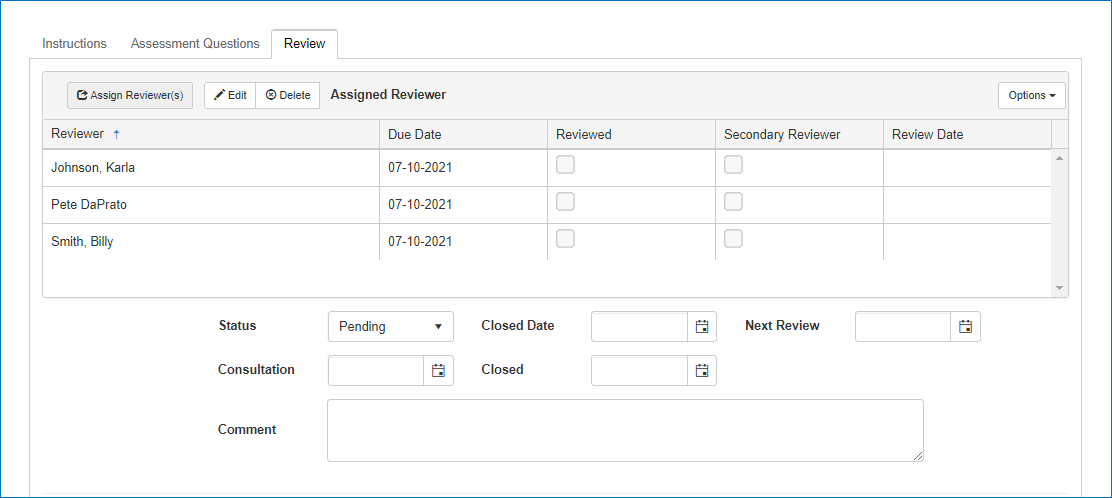
- Form Questions/Comments (Clarification)
Each reviewer that has been assigned to a specific form(s) will have a Review tab available for the specific form that they are required to review. This Review tab is used to update the disposition of the review process. In addition, a new reviewer can be assigned via this form. As a person reviews a form, each reviewer is able to review all pages of the form submitted. Each question indicates a flag that refers to a field that generates a question entry box for the specific subcategory or specific question.

The flag will create the following entry form.
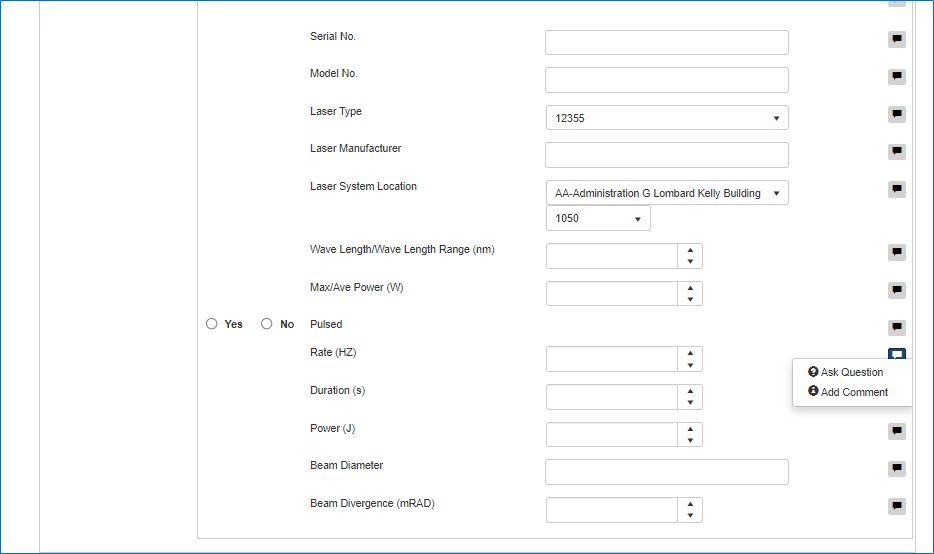
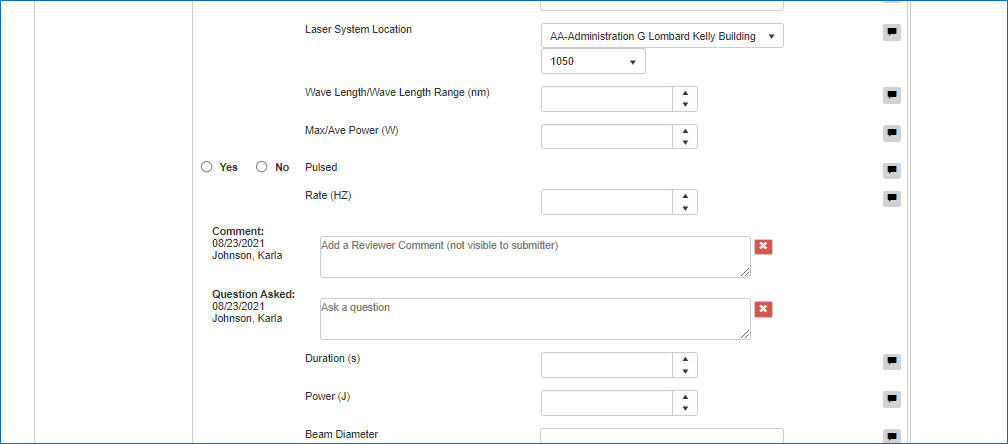
- A reviewer can make comments or ask questions. The comments will not be seen by the submitter, only questions are shown to the individual submitter. The comments are meant for reviewers to post notes or comments for themselves and other reviwers of the questionnare. There are a number of different approaches to the questioning/comments capability of this form.
- Comments can be shown to the reviewer and then summarized by a primary reviewer and sent to the submitter all at once. This way, the submitter will not get multiple versions of the same question and is useful with committee reviews. The other approach is to have each question immediately sent to the submitter at the time the questions are asked.
- The question/comments asked section indicates who is asking the question, the date, and the question. Once the question(s) are asked, an Email will be sent to the submitter indicating the questions that require clarification. These questions are generated once the [Save] button is clicked.
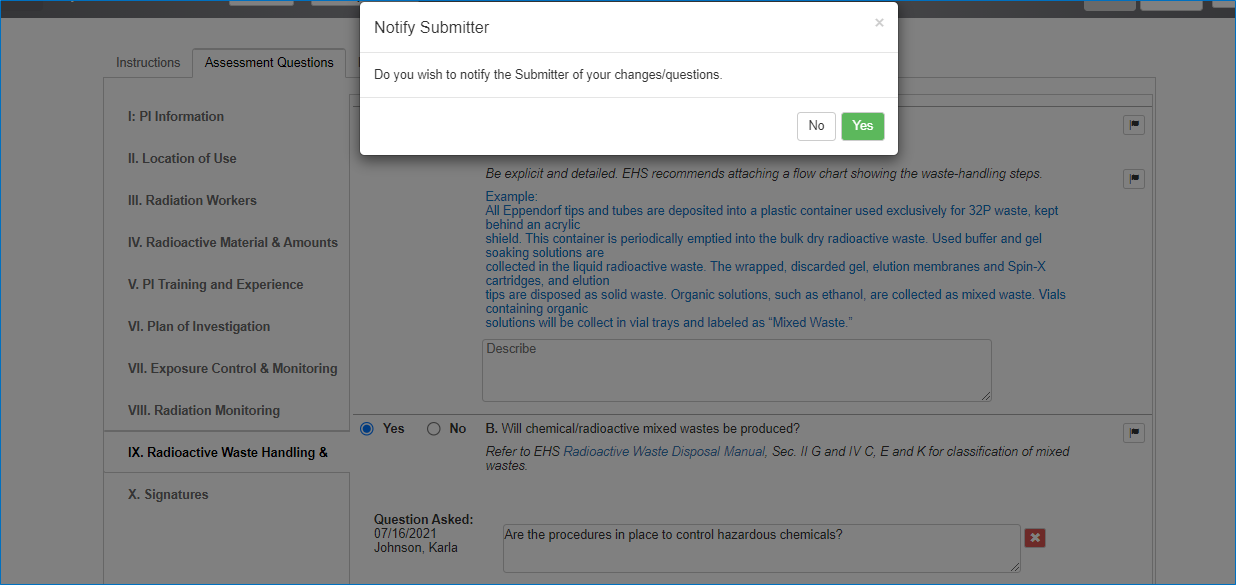
If the reviewer answers 'Yes' to this question, an email is generated containing a link to the questions asked to the submitter from the reviewer(s). The email is displayed with the institution's graphics in this format.
Here is an example of the email:
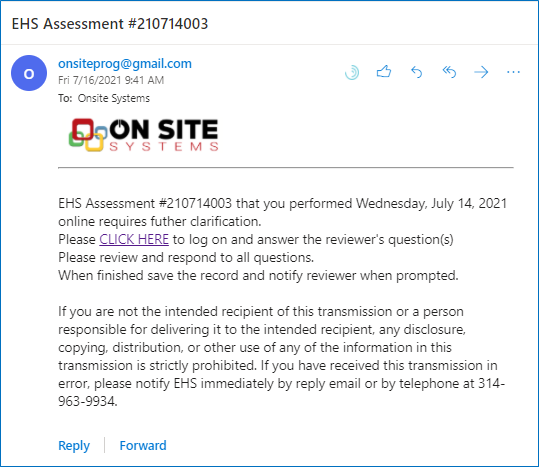
The submitter or recepient has the option to CLICK HERE on the link to review the questions or/and provide clarification required by the reviewer(s).
- Responding to a Question(s)
Once the submitter opens the document containing the posted reviewer questions, the submitter is required to answer the questions in the format of the form provided.

Only sections with questions will appear. All sections with open questions will have a number indicator listed to the left of the subcategory. This indicates which subcategory contains unanswered questions. The following is a example of a question asked by a reviewer to a submitter.

The response field is now awaiting a response. The question should be answered in the space provided. Once all questions are answered, click [Save] and the Reviewer will be notified with your response.
This is an example of the notification email for responses:
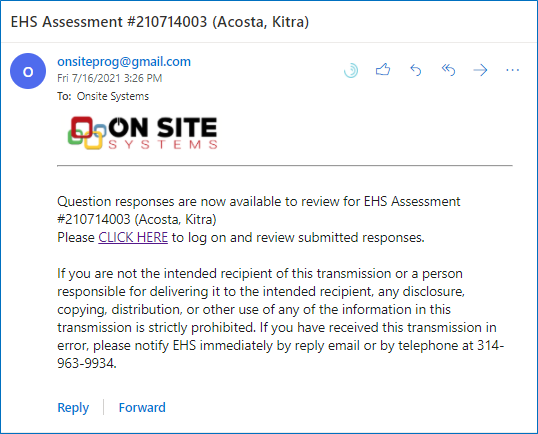
- Form Approval
Form approval is implemented once all questions and clarifications have been completed. Typically, the primary reviewer will make the final approval of the form submitted and update the Status from the dropdown. This will occur after the committee approval meeting. The Close Date and Next Review dates can be set at this time.
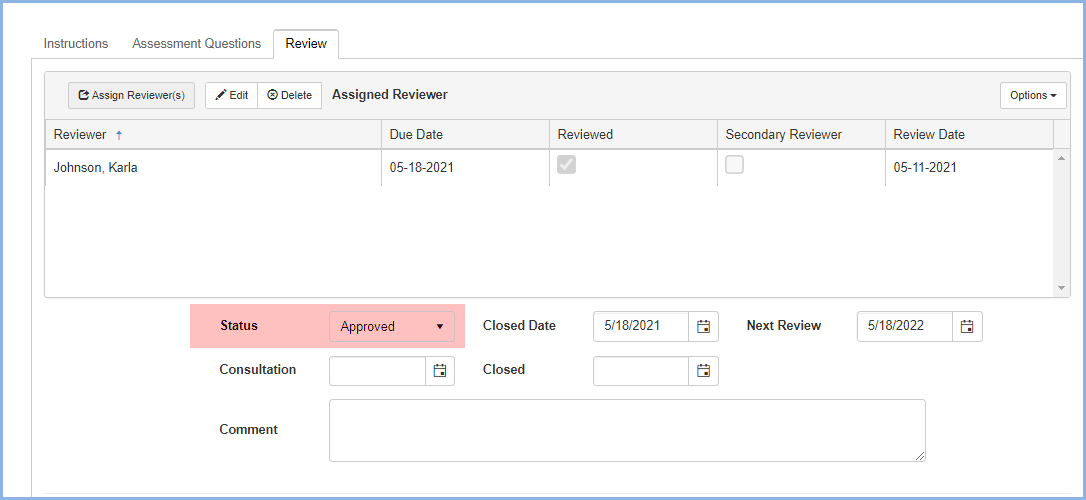
- Form Recommendation(s) entry/update
Once the form/application has been approved, there are recommendations that have been potentially created from the results of the answers entered. The following example shows the types of recommendations that can be created based upon the recommendations assigned to a specific question. These recommendations can be both updated at the worker level and/or at the permit level. This is extremely important since this process can help not only in the analysis of the submittal but also in the actual updating of the many applications within EHS. A simple example of this might be asking a question with training requirements added and updated dependent upon the answer to the question.
